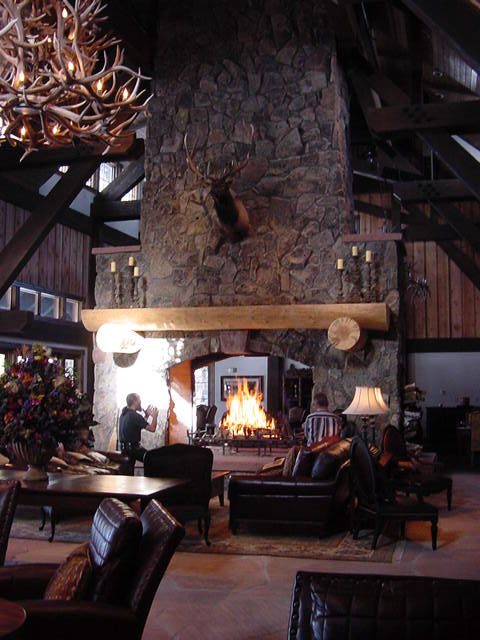
|
Rumford Technical Discussion The Skinny on See-Throughs Lovely but temperamental To ask technical questions or contribute to the discussion click here |
|
Summary: The eight foot wide see-through fireplace at the Lodge can be made to work provided there is an adequate and balanced air supply. The fireplace, however, is very temperamental. Here are some specific ideas about how to make it work better. The main point, of course, might be to understand just how temperamental these fireplace are. Back-to-back Rumfords are always more versatile, more efficient and less troublesome than any "see-through" fireplace. See-through fireplaces are temperamental and inefficient and we don't recommend them. Size of fireplace: 8'-2" wide x 5'-6" at top of arch and 4'-10" at shoulder (5'-3"ave) arched top double-sided fireplace. Throat 98" x 10". Flue 24"x72". Air through throat - 4,175.2 cfm at very slight negative pressure. Measured with hand-held rotating vane airspeed meter. Readings ranged from about 550 to 670 ft/min. (614av ft/min x (10"x98"=980/144=6.8sq.ft.) = 4,175.2 cfm. Slight negative pressure accomplished by pumping 5400 cfm into room through kitchen, yet opening a door showed the indoor pressure still to be slightly negative. Other tests with damper closed, etc. led us to believe room was "losing" about 2000 cfm in addition to the fireplace for a total of about 7400 cfm so, even with the kitchen make-up fan pumping 5400cfm into the great room, we could not quite achieve neutral pressure. Air through one face - about 2000cfm. The air flowing into one of the faces of the fireplace varied considerably in speed from top to bottom. Near the top for about 12" down the speed meter measured about 130 ft/min with a range of 117 in the center to 145 at the sides. (That was surprizing and may be due to the arch.) The air flow into the lower 4/5ths of the opening was very slow and irregular - hardly measurable - and I will guess at 20 ft/min average. We didn't do a very complete objective test in that we assumed the air would be flowing in both faces equally and we didn't establish a grid to record readings over the whole face. 130ft/min x top 8sq.ft. = 1040cfm + 25ft/min x bottom 32sq.ft. = 800cfm for a total of 1840cfm. Note that 1840cfm is almost half of the 4,175cfm more easily measured through the throat as expected. 1840cfm / 40sq.ft. = 46ft/min or 0.76ft.sec. - roughly four times the minimum of 0.2ft/sec. that ASHRAE says is a minimum for regular fireplaces. Flue calculations: A PE consultant estimated the fireplace would need 3600cfm which was about right. Based on the ASHRAE recommendations of 0.2ft/sec X 40sq.ft. face area = 8cfs or 480cfm, we had estimated the fireplace with two faces would need a minimum of 1500cfm
|
Evaluation: The system needs a minimum draft - minimum yet to be determined but apparently about 4000cfm - natural draft at near neutral indoor pressure. In addition the supply must be balanced. The draft seems to be unstable or barely stable so that if minor changes in room pressures of air movements can result in most of the air the system needs flowing in only one side at the expense of the other, forcing the smoke toward and spilling out of the other face. Each face needs some minimum flow or face velocity to keep the fireplace from smoking. Our best plan is to install two big variable speed fans on either side of the great room blowing lots of air as slowly as possible down the two flanking hallways. The idea will be to 1) provide enough air to establish neutral pressure - about 4000cfm plus whatever else the room needs which appears to be about 2000cfm more - and 2) in a balanced way so that about 2000cfm flow into each face of the fireplace. If the fireplace is smoking out of one side the air on that side could be increased, or the air on the other side reduced, to balance the flows into the two faces. The pressures are so small and the variables so many that this might be an impossible system to manage. Hopefully stability will increase with an increase of total air flow. Better efficiency might be achieved with less air flow if it could somehow be automatically ballanced. Todd reminded us that we have never seen a positive pressure condition with this fireplace to know how it will work. It may stabilize when it gets positive pressure and adequate make up air. What effect would a door on one side have? What about a screen if a door is not acceptable? Todd said he had seen screens that have more effect on a fireplace than expected. We wanted to go back - try the fans, try screens on one or both sides, smooth out the throat which is not well streamlined at the arch - but we never got the chance. Maybe we should have tried exhaust fans to pull the smoke out rather than trying to push it through the fireplace with psitive pressure. At the time I didn't know the exhaust fans were large enough or could be ganged. As Todd insightfully asked: "Have your ever tried to push with a rope?" After the fact, we became interested in Japanese and American Indian fires with no chimneys yet the smoke is vented through high windows or the hole at the top of the teepee. Maybe in this lodge, with high ceilings and natural rustic wood finishes, managing the little smoke that we couldn't control by venting it out high in the ceiling would have been acceptable. Conclusion: Build back-to-back Rumfords.
|
Chimney / Flue / Smoke Test / Throat

[Back to Technical Discussion]
Buckley Rumford Fireplace Home Page
Copyright 1996 - 2002 Jim Buckley
All rights reserved.
webmaster